Identification Tools of Microplastics from Surface Water Integrating Digital Image Processing and Statistical Techniques
Abstract
:1. Introduction
2. Materials and Methods
2.1. Analysed Samples
2.2. Sampling and Preliminary Sample Preparation
2.3. Digital Microscopy
2.4. Image Processing and Analysis
2.5. Microplastic Characteristics/Morphology
2.6. Statistical Analysis
3. Results and Discussion
3.1. Characteristics of Microplastics
3.2. Shape 2D and Colour of Microplastics
4. Summary and Conclusions
Author Contributions
Funding
Institutional Review Board Statement
Informed Consent Statement
Data Availability Statement
Conflicts of Interest
References
- Freeman, S.; Booth, A.M.; Sabbah, I.; Tiller, R.; Dierking, J.; Klun, K.; Rotter, A.; Ben-David, E.; Javidpour, J.; Angel, D.L. Between source and sea: The role of wastewater treatment in reducing marine microplastics. J. Environ. Manag. 2020, 226, 110642. [Google Scholar] [CrossRef]
- Urban-Malinga, B.; Zalewski, M.; Jakubowska, A.; Wodzinowski, T.; Malinga, M.; Pałys, B.; Dąbrowska, A. Microplastics on sandy beaches of the southern Baltic Sea. Mar. Pollut. Bull. 2020, 155, 111170. [Google Scholar] [CrossRef] [PubMed]
- Esiukova, E. Plastic pollution on the Baltic beaches of Kaliningrad region, Russia. Mar. Pollut. Bull. 2017, 114, 1072–1080. [Google Scholar] [CrossRef]
- Merlino, S.; Locritani, M.; Bernardi, G.; Como, C.; Legnaioli, S.; Palleschi, V.; Abbate, M. Spatial and temporal distribution of chemically characterized microplastics within the protected area of pelagos sanctuary (Nw mediterranean sea): Focus on natural and urban beaches. Water 2020, 12, 3389. [Google Scholar] [CrossRef]
- Chubarenko, I.; Bagaev, A.; Zobkov, M.; Esiukova, E. On some physical and dynamical properties of microplastic particles in marine environment. Mar. Pollut. Bull. 2016, 108, 105–112. [Google Scholar] [CrossRef] [PubMed]
- GESAMP. Guidelines for the monitoring and assessment of plastic litter in the ocean. GESAMP Rep. Stud. 2019, 99, 130. [Google Scholar]
- Waldschläger, K.; Schüttrumpf, H. Effects of particle properties on the settling and rise velocities of microplastics in freshwater under laboratory conditions. Environ. Sci. Technol. 2019, 53, 1958–1966. [Google Scholar] [CrossRef]
- Ismayilova, I.; Zeyer, T.; Timpf, S. Identification of Microplastics in Soils Using 2D Geometric Shape Descriptors. AGILE GISci. Ser. 2021, 2, 32. [Google Scholar] [CrossRef]
- Waldschläger, K.; Brückner, M.Z.; Almroth, B.C.; Hackney, C.R.; Adyel, T.M.; Alimi, O.S.; Belontz, S.L.; Cowger, W.; Doyle, D.; Gray, A.; et al. Learning from natural sediments to tackle microplastics challenges: A multidisciplinary perspective. Earth-Sci. Rev. 2022, 228, 104021. [Google Scholar] [CrossRef]
- Dietrich, W.E. Settling velocity of natural particles. Water Resour. Res. 1982, 18, 1615–1626. [Google Scholar] [CrossRef]
- Song, Y.K.; Hong, S.H.; Jang, M.; Han, G.M.; Jung, S.W.; Shim, W.J. Combined effects of UV exposure duration and mechanical abrasion on microplastic fragmentation by polymer type. Environ. Sci. Technol. 2017, 51, 4368–4376. [Google Scholar] [CrossRef] [PubMed]
- Sarkar, A.K.; Rubin, A.E.; Zucker, I. Engineered polystyrene-based microplastics of high environmental relevance. Environ. Sci. Technol. 2021, 55, 10491–10501. [Google Scholar] [CrossRef] [PubMed]
- Waldschläger, K.; Born, M.; Cowger, W.; Gray, A.; Schüttrumpf, H. Settling and rising velocities of environmentally weathered micro-and macroplastic particles. Environ. Res. 2020, 191, 110192. [Google Scholar] [CrossRef] [PubMed]
- Shi, Y.; Shi, L.; Huang, H.; Ye, K.; Yang, L.; Wang, Z.; Sun, Y.; Li, D.; Shi, Y.; Xiao, L.; et al. Analysis of aged microplastics: A review. Environ. Chem. Lett. 2024, 22, 1861–1888. [Google Scholar] [CrossRef]
- Alimi, O.S.; Claveau-Mallet, D.; Lapointe, M.; Biu, T.; Liu, L.; Hernandez, L.M.; Bayen, S.; Tufenkji, N. Effects of Weathering on the Properties and Fate of Secondary Microplastics from a Polystyrene Single-Use Cup. J. Hazard. Mater. 2023, 459, 131855. [Google Scholar] [CrossRef] [PubMed]
- Hidalgo-Ruz, V.; Gutow, L.; Thompson, R.C.; Thiel, M. Microplastics in the marine environment: A review of the methods used for identification and quantification. Environ. Sci. Technol. 2012, 46, 3060–3075. [Google Scholar] [CrossRef] [PubMed]
- Karkanorachaki, K.; Syranidou, E.; Kalogerakis, N. Sinking characteristics of microplastics in the marine environment. Sci. Total Environ. 2021, 793, 148526. [Google Scholar] [CrossRef]
- Francalanci, S.; Paris, E.; Solari, L. On the prediction of settling velocity for plastic particles of different shapes. Environ. Pollut. 2021, 290, 118068. [Google Scholar] [CrossRef]
- Nguyen, T.H. Settling behaviour of irregular-shaped polystyrene microplastics. VNUHCM J. Eng. Technol. 2021, 4, 1229–1238. [Google Scholar] [CrossRef]
- Yao, P.; Li, C.; Xiao, S. Effect of ultraviolet aging on properties and structure of polystyrene. Huagong Xuebao/CIESC J. 2014, 65, 4620–4626. [Google Scholar] [CrossRef]
- Barus, B.S.; Chen, K.; Cai, M.; Li, R.; Chen, H.; Li, C.; Wang, J.; Cheng, S.Y. Heavy metal adsorption and release on polystyrene particles at various salinities. Front. Mar. Sci. 2021, 8, 671802. [Google Scholar] [CrossRef]
- Khalid, N.; Aqeel, M.; Noman, A.; Khan, S.M.; Akhter, N. Interactions and effects of microplastics with heavy metals in aquatic and terrestrial environments. Environ. Pollut. 2021, 290, 118104. [Google Scholar] [CrossRef] [PubMed]
- Paul-Pont, I.; Lacroix, C.; González Fernández, C.; Hégaret, H.; Lambert, C.; Le Goïc, N.; Frère, L.; Cassone, A.-L.; Sussarellu, R.; Fabioux, C.; et al. Exposure of marine mussels Mytilus spp. to polystyrene microplastics: Toxicity and influence on fluoranthene bioaccumulation. Environ. Pollut. 2016, 216, 724–737. [Google Scholar] [CrossRef] [PubMed]
- Ho, W.K.; Law, J.C.F.; Zhang, T.; Leung, K.S.Y. Effects of weathering on the sorption behavior and toxicity of polystyrene microplastics in multi-solute systems. Water Res. 2020, 187, 116419. [Google Scholar] [CrossRef] [PubMed]
- Sjollema, S.B.; Redondo-Hasselerharm, P.; Leslie, H.A.; Kraak, M.H.; Vethaak, A.D. Do plastic particles affect microalgal photosynthesis and growth? Aquat. Toxicol. 2016, 170, 259–261. [Google Scholar] [CrossRef] [PubMed]
- Mao, Y.; Ai, H.; Chen, Y.; Zhang, Z.; Zeng, P.; Kang, L.; Li, W.; Gu, W.; He, Q.; Li, H. Phytoplankton response to polystyrene microplastics: Perspective from an entire growth period. Chemosphere 2018, 208, 59–68. [Google Scholar] [CrossRef] [PubMed]
- Jalaudin Basha, N.N.; Adzuan Hafiz, N.B.; Osman, M.S.; Abu Bakar, N.F. Unveiling the noxious effect of polystyrene microplastics in aquatic ecosystems and their toxicological behavior on fishes and microalgae. Front. Toxicol. 2023, 5, 1135081. [Google Scholar] [CrossRef] [PubMed]
- Reynolds, C.; Ryan, P.G. Micro-plastic ingestion by waterbirds from contaminated wetlands in South Africa. Mar. Pollut. Bull. 2018, 126, 330–333. [Google Scholar] [CrossRef] [PubMed]
- Hämer, J.; Gutow, L.; Köhler, A.; Saborowski, R. Fate of microplastics in the marine isopod Idotea emarginata. Environ. Sci. Technol. 2014, 48, 13451–13458. [Google Scholar] [CrossRef] [PubMed]
- Besseling, E.; Wang, B.; Lurling, M.; Koelmans, A.A. Nanoplastic affects growth of S. obliquus and reproduction of D. magna. Environ. Sci. Technol. 2014, 48, 12336–12343. [Google Scholar] [CrossRef]
- Usman, S.; Abdull Razis, A.F.; Shaari, K.; Amal, M.N.A.; Saad, M.Z.; Mat Isa, N.; Nazarudin, M.F. Polystyrene microplastics exposure: An insight into multiple organ histological alterations, oxidative stress and neurotoxicity in Javanese medaka fish (Oryzias javanicus Bleeker, 1854). Int. J. Environ. Res. Public Health 2021, 18, 9449. [Google Scholar] [CrossRef]
- Masura, J.; Baker, J.E.; Foster, G.D.; Arthur, C.; Herring, C. Laboratory Methods for the Analysis of Microplastics in the Marine Environment: Recommendations for Quantifying Synthetic Particles in Waters and Sediments; NOAA Technical Memorandum NOS-OR&R-48; NOAA Marine Debris Division: Silver Spring, MD, USA, 2015. [Google Scholar]
- Zhang, S.; Yang, X.; Gertsen, H.; Peters, P.; Salánki, T.; Geissen, V. A simple method for the extraction and identification of light density microplastics from soil. Sci. Total Environ. 2018, 616, 1056–1065. [Google Scholar] [CrossRef]
- Valente, T.; Ventura, D.; Matiddi, M.; Sbrana, A.; Silvestri, C.; Piermarini, R.; Jacomini, C.; Costantini, M.L. Image processing tools in the study of environmental contamination by microplastics: Reliability and perspectives. Environ. Sci. Pollut. Res. 2023, 30, 298–309. [Google Scholar] [CrossRef]
- Dacewicz, E.; Bergel, T.; Łobos-Moysa, E.; Moraczewska-Majkut, K.; Nocoń, W. Microplastic and mesoplastic in stagnation of the vistula water in highly urbanized areas of the Krakow poviat-preliminary research. Acta Sci. Pol. Form. Circumiectus 2021, 20, 5–17. [Google Scholar] [CrossRef]
- Horton, A.A.; Svendsen, C.; Williams, R.J.; Spurgeon, D.J.; Lahive, E. Large microplastic particles in sediments of tributaries of the River Thames, UK–Abundance, sources and methods for effective quantification. Mar. Pollut. Bull. 2017, 114, 218–226. [Google Scholar] [CrossRef]
- Nel, H.A.; Dalu, T.; Wasserman, R.J.; Hean, J.W. Colour and size influences plastic microbead underestimation, regardless of sediment grain size. Sci. Total Environ. 2019, 655, 567–570. [Google Scholar] [CrossRef]
- Wendt-Potthoff, K.; Avellán, T.; van Emmerik, T.; Hamester, M.; Kirschke, S.; Kitover, D.; Schmidt, C. Monitoring Plastics in Rivers and Lakes: Guidelines for the Harmonization of Methodologies; United Nations Environment Programme: Nairobi, Kenya, 2020; pp. 1–108. [Google Scholar]
- Shanthi, C.; Porpatham, R.K.; Pappa, N. Image analysis for particle size distribution. Int. J. Eng. Technol. 2014, 6, 1340–1345. [Google Scholar]
- Mintenig, S.M.; Int-Veen, I.; Löder, M.G.; Primpke, S.; Gerdts, G. Identification of microplastic in effluents of waste water treatment plants using focal plane array-based micro-Fourier-transform infrared imaging. Water Res. 2017, 108, 365–372. [Google Scholar] [CrossRef]
- ANNEX. Annex to the Commission Delegated Decision Supplementing Directive (EU) 2020/2184 of the European Parliament and of the Council by Laying Down a Methodology to Measure Microplastics in Water Intended for Human Consumption. 11 March 2024. Available online: https://eur-lex.europa.eu/legal-content/PL/TXT/PDF/?uri=OJ:L_202401441&qid=1721580082325 (accessed on 19 July 2024).
- ISO 13322-1:2014; Particle Size Analysis—Image Analysis Methods—Part 1: Static Image Analysis Methods. ISO: London, UK, 2014.
- Li, M.; Wilkinson, D.; Patchigolla, K. Comparison of particle size distributions measured using different techniques. Part. Sci. Technol. 2005, 23, 265–284. [Google Scholar] [CrossRef]
- Rosal, R. Morphological description of microplastic particles for environmental fate studies. Mar. Pollut. Bull. 2021, 171, 112716. [Google Scholar] [CrossRef]
- Schnepf, U.; von Moers-Meßmer, M.A.L.; Brümmer, F. A practical primer for image-based particle measurements in microplastic research. Microplast. Nanoplast. 2023, 3, 16. [Google Scholar] [CrossRef]
- Holjević, T.; Družeta, S.; Grbčić, L.; Alvir, M. Empirical Shape-Based Estimation of Settling Microplastic Particles Drag Coefficient. J. Mar. Sci. Eng. 2023, 11, 2166. [Google Scholar] [CrossRef]
- Jolliffe, I.T. Principal Component Analysis. Technometrics 2003, 45, 276. [Google Scholar]
- Hussain, S.; Sial, N.; Nawaz, Z.; Naeem, M.; Habib, R.Z.; Thiemann, T. Presence of microplastic in personal care and cosmetic products from markets in Punjab, Pakistan. 2023. [CrossRef]
- Metz, T.; Koch, M.; Lenz, P. Quantification of microplastics: Which parameters are essential for a reliable inter-study comparison? Mar. Pollut. Bull. 2020, 157, 111330. [Google Scholar] [CrossRef]
- Šunta, U.; Trebše, P.; Kralj, M.B. Simply applicable method for microplastics determination in environmental samples. Molecules 2021, 26, 1. [Google Scholar] [CrossRef] [PubMed]
- Bond, T.; Morton, J.; Al-Rekabi, Z.; Cant, D.; Davidson, S.; Pei, Y. Surface properties and rising velocities of pristine and weathered plastic pellets. Environ. Sci. Process. Impacts 2022, 24, 794–804. [Google Scholar] [CrossRef]
- Kim, S.; Hyeon, Y.; Park, C. Microplastics’ Shape and Morphology Analysis in the Presence of Natural Organic Matter Using Flow Imaging Microscopy. Molecules 2023, 28, 6913. [Google Scholar] [CrossRef] [PubMed]
- Strady, E.; Dang, T.H.; Dao, T.D.; Dinh, H.N.; Do, T.T.D.; Duong, T.N.; Hoang, D.A.; Kieu-Le, T.C.; Le, T.P.; Mai, H. Baseline assessment of microplastic concentrations in marine and freshwater environments of a developing Southeast Asian country, Viet Nam. Mar. Pollut. Bull. 2021, 162, 111870. [Google Scholar] [CrossRef]
- Uurasjärvi, E.; Hartikainen, S.; Setälä, O.; Lehtiniemi, M.; Koistinen, A. Microplastic concentrations, size distribution, and polymer types in the surface waters of a northern European lake. Water Environ. Res. 2020, 92, 149–156. [Google Scholar] [CrossRef]
- Finnegan, A.; Süsserott, R.C.; Koh, L.H.; Teo, W.B.; Gouramanis, C. A Simple Sample Preparation Method to Significantly Improve Fourier Transform Infrared (FT-IR) Spectra of Microplastics. Appl. Spectrosc. 2022, 76, 783–792. [Google Scholar] [CrossRef]
- Yang, L.; Zhang, Y.; Kang, S.; Wang, Z.; Wu, C. Microplastics in freshwater sediment: A review on methods, occurrence, and sources. Sci. Total Environ. 2021, 754, 141948. [Google Scholar] [CrossRef] [PubMed]
- de Carvalho, A.R.; Garcia, F.; Riem-Galliano, L.; Tudesque, L.; Albignac, M.; Ter Halle, A.; Cucherousset, J. Urbanization and hydrological conditions drive the spatial and temporal variability of microplastic pollution in the Garonne River. Sci. Total Environ. 2021, 769, 144479. [Google Scholar] [CrossRef] [PubMed]
- Henny, C.; Rohaningsih, D.; Suryono, T.; Santoso, A.; Waluyo, A. Microplastic pollution in the surface water of Lake Singkarak, Indonesia. IOP Conf. Ser. Earth Environ. Sci. 2022, 1118, 012050. [Google Scholar] [CrossRef]
- D’Hont, A.; Gittenberger, A.; Leuven, R.S.E.W.; Hendriks, J. Dropping the microbead: Source and sink related microplastic distribution in the Black Sea and Caspian Sea basins. Mar. Pollut. Bull. 2021, 173, 112982. [Google Scholar] [CrossRef] [PubMed]
- Erdoğan, Ş. Microplastic pollution in freshwater ecosystems: A case study from Turkey. Ege J. Fish. Aquat. Sci. 2020, 37, 213–221. [Google Scholar] [CrossRef]
- Gabrijelčič Tomc, H.; Hladnik, A. 1D and 2D Shape Descriptors Applied in Fabric Drape Computer Simulation. Fibres Text. East. Eur. 2015, 6, 92–101. [Google Scholar] [CrossRef]
- Li, L.; Iskander, M. Evaluation of roundness parameters in use for sand. J. Geotech. Geoenviron. Eng. 2021, 147, 04021081. [Google Scholar] [CrossRef]
- Panunzi, G.; Valente, T.; Matiddi, M.; Lasinio, G.J. A preliminary study on shape descriptors for the characterization of microplastics ingested by fish. In Book of the Short Papers; Pearson: London, UK, 2023; pp. 1015–1020. [Google Scholar]
- Güven, O.; Gökdağ, K.; Jovanović, B.; Kıdeyş, A.E. Microplastic litter composition of the Turkish territorial waters of the Mediterranean Sea, and its occurrence in the gastrointestinal tract of fish. Environ. Pollut. 2017, 223, 286–294. [Google Scholar] [CrossRef] [PubMed]
- Karlsson, T.M.; Vethaak, A.D.; Almroth, B.C.; Ariese, F.; van Velzen, M.; Hassellöv, M.; Leslie, H.A. Screening for microplastics in sediment, water, marine invertebrates and fish: Method development and microplastic accumulation. Mar. Pollut. Bull. 2017, 122, 403–408. [Google Scholar] [CrossRef]
- Lin, X.; Gowen, A.A.; Pu, H.; Xu, J.-L. Microplastic contamination in fish: Critical review and assessment of data quality. Food Control 2023, 153, 109939. [Google Scholar] [CrossRef]
- Arpia, A.A.; Chen, W.H.; Ubando, A.T.; Naqvi, S.R.; Culaba, A.B. Microplastic degradation as a sustainable concurrent approach for producing biofuel and obliterating hazardous environmental effects: A state-of-the-art review. J. Hazard. Mater. 2021, 418, 126381. [Google Scholar] [CrossRef] [PubMed]
- Zhu, L.; Zhao, S.; Bittar, T.B.; Stubbins, A.; Li, D. Photochemical dissolution of buoyant microplastics to dissolved organic carbon: Rates and microbial impacts. J. Hazard. Mater. 2020, 383, 121065. [Google Scholar] [CrossRef] [PubMed]
- Lin, Z.; Jin, T.; Zou, T.; Xu, L.; Xi, B.; Xu, D.; He, J.; Xiong, L.; Tang, C.; Peng, J.; et al. Current progress on plastic/microplastic degradation: Fact influences and mechanism. Environ. Pollut. 2022, 304, 119159. [Google Scholar] [CrossRef]
- Chalmers, J.M.; Meier, R.J. (Eds.) Polymer Degradation and Oxidation: An Introduction. In Molecular Characterization and Analysis of Polymers; Elsevier: Amsterdam, The Netherlands, 2008; Volume 53, pp. 387–450. [Google Scholar]
- Sorasan, C.; Edo, C.; González-Pleiter, M.; Fernández-Piñas, F.; Leganés, F.; Rodríguez, A.; Rosal, R. Ageing and fragmentation of marine microplastics. Sci. Total Environ. 2022, 827, 154438. [Google Scholar] [CrossRef] [PubMed]
- Julienne, F.; Delorme, N.; Lagarde, F. From macroplastics to microplastics: Role of water in the fragmentation of polyethylene. Chemosphere 2019, 236, 124409. [Google Scholar] [CrossRef]
- Kadac-Czapska, K.; Knez, E.; Gierszewska, M.; Olewnik-Kruszkowska, E.; Grembecka, M. Microplastics Derived from Food Packaging Waste—Their Origin and Health Risks. Materials 2023, 16, 674. [Google Scholar] [CrossRef]

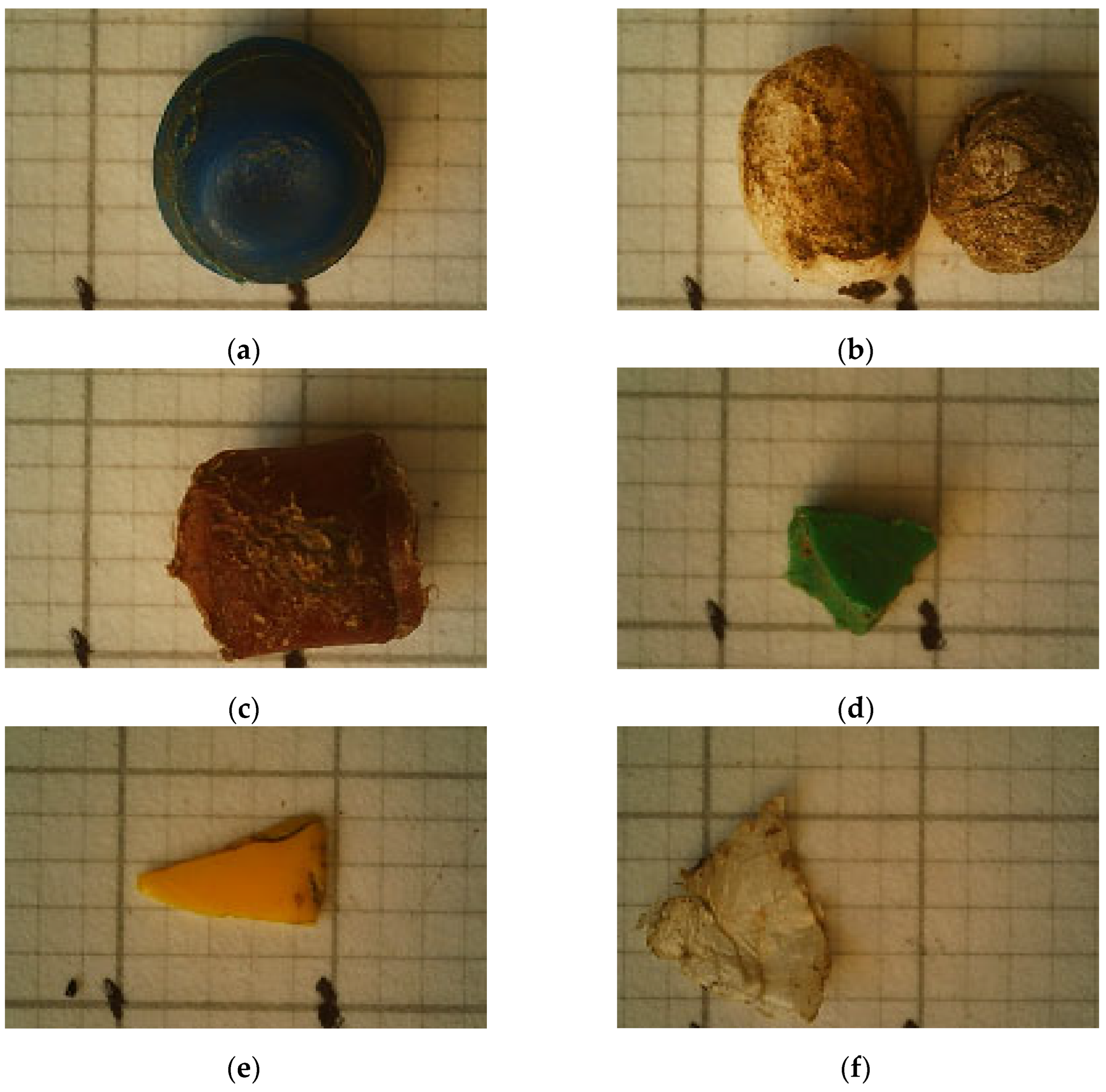
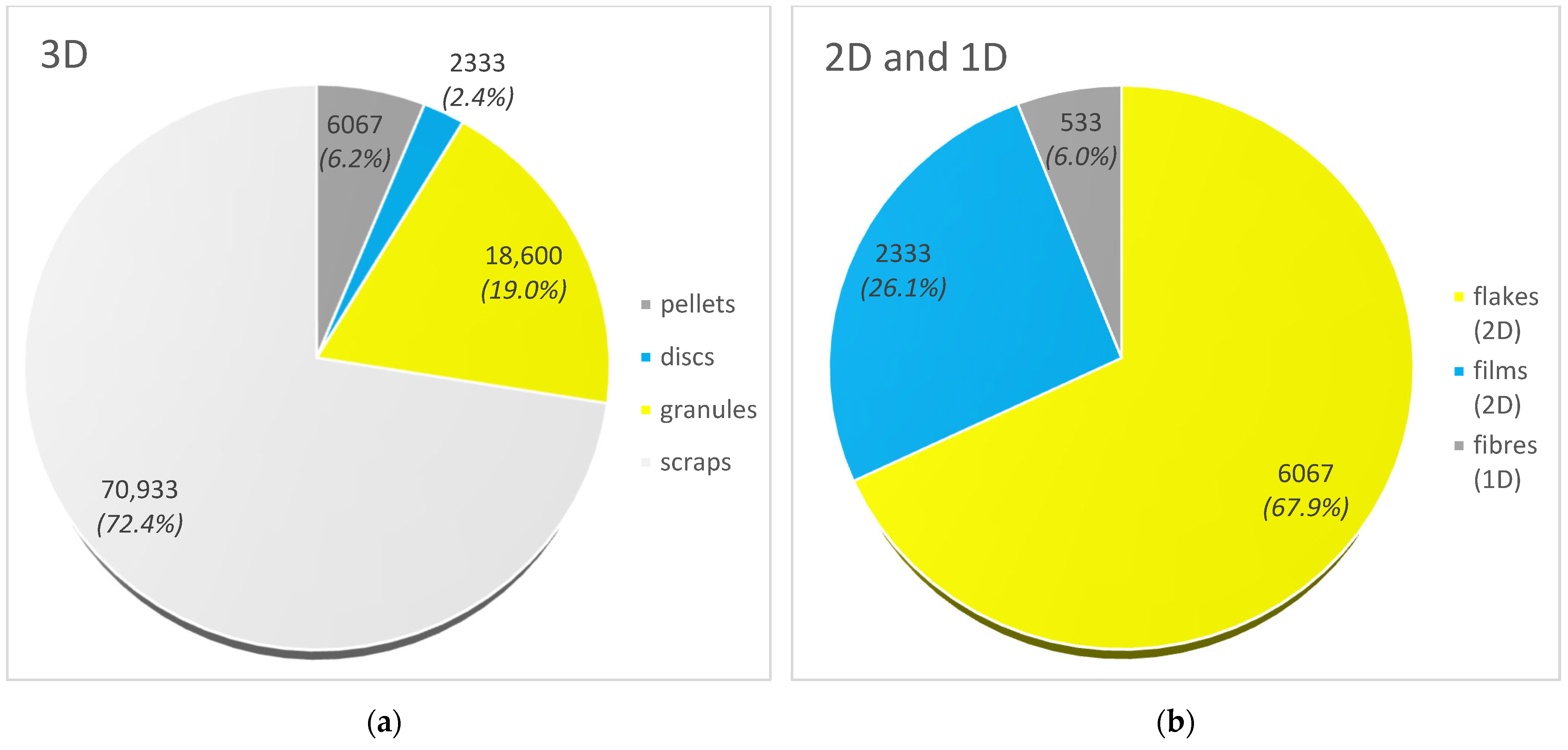
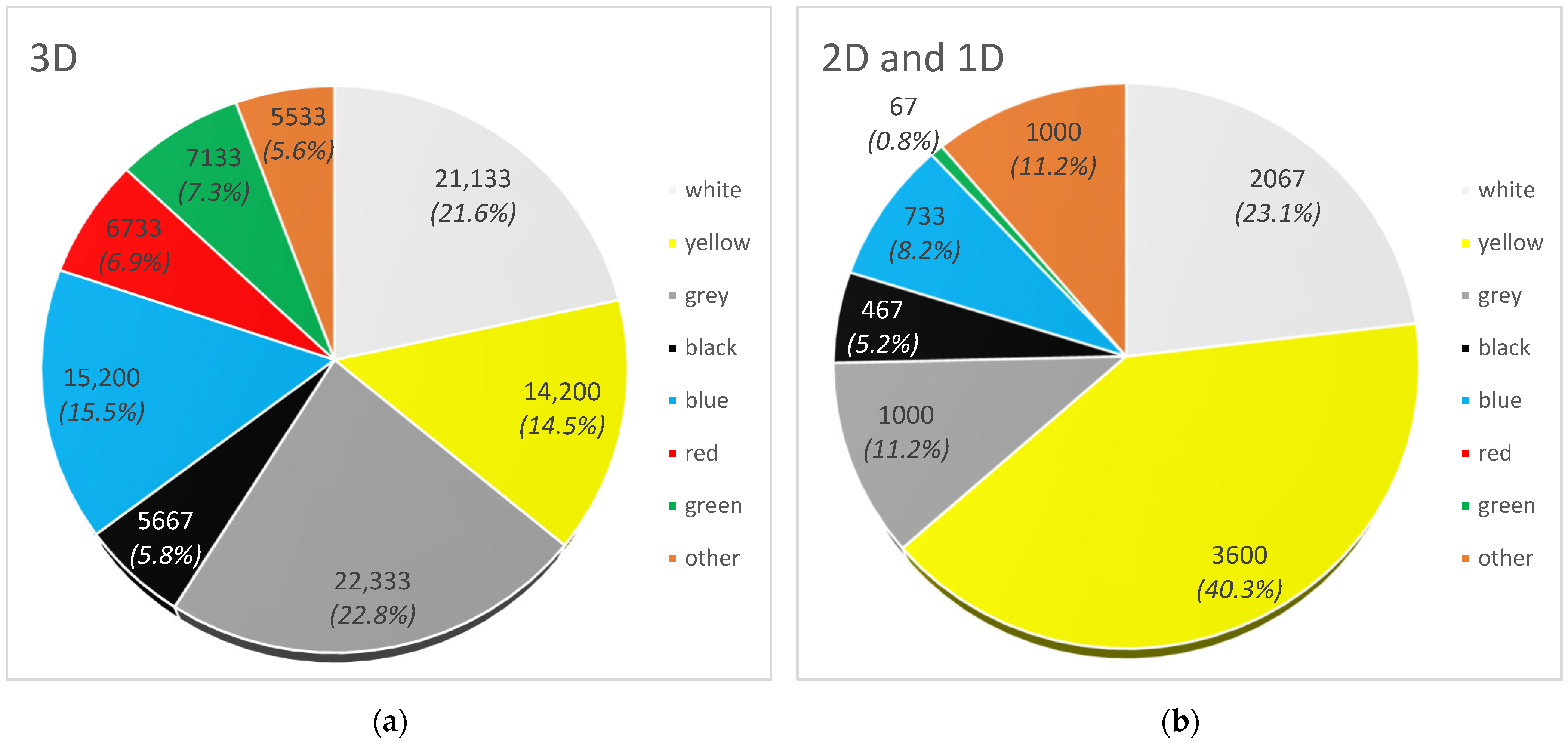
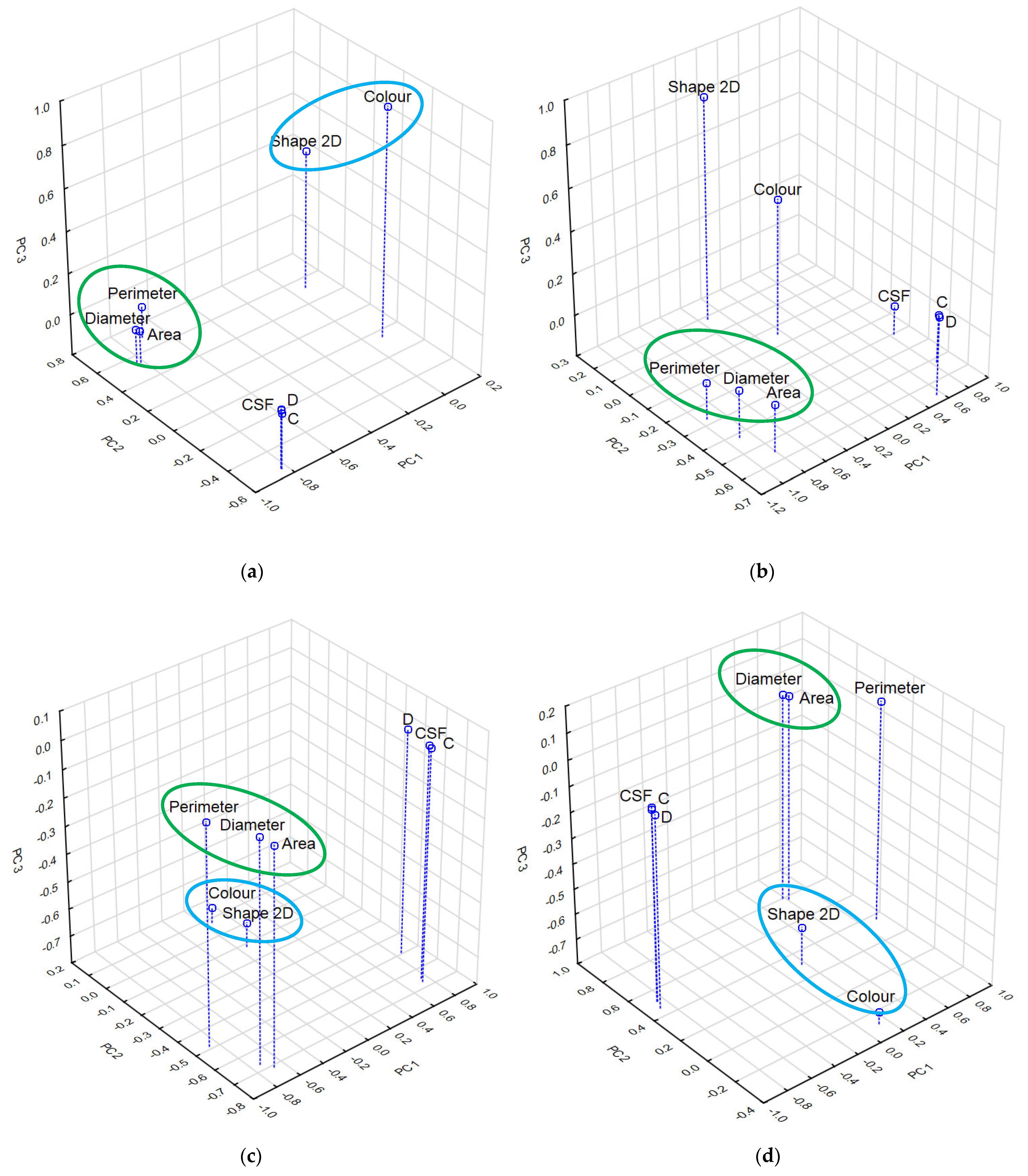
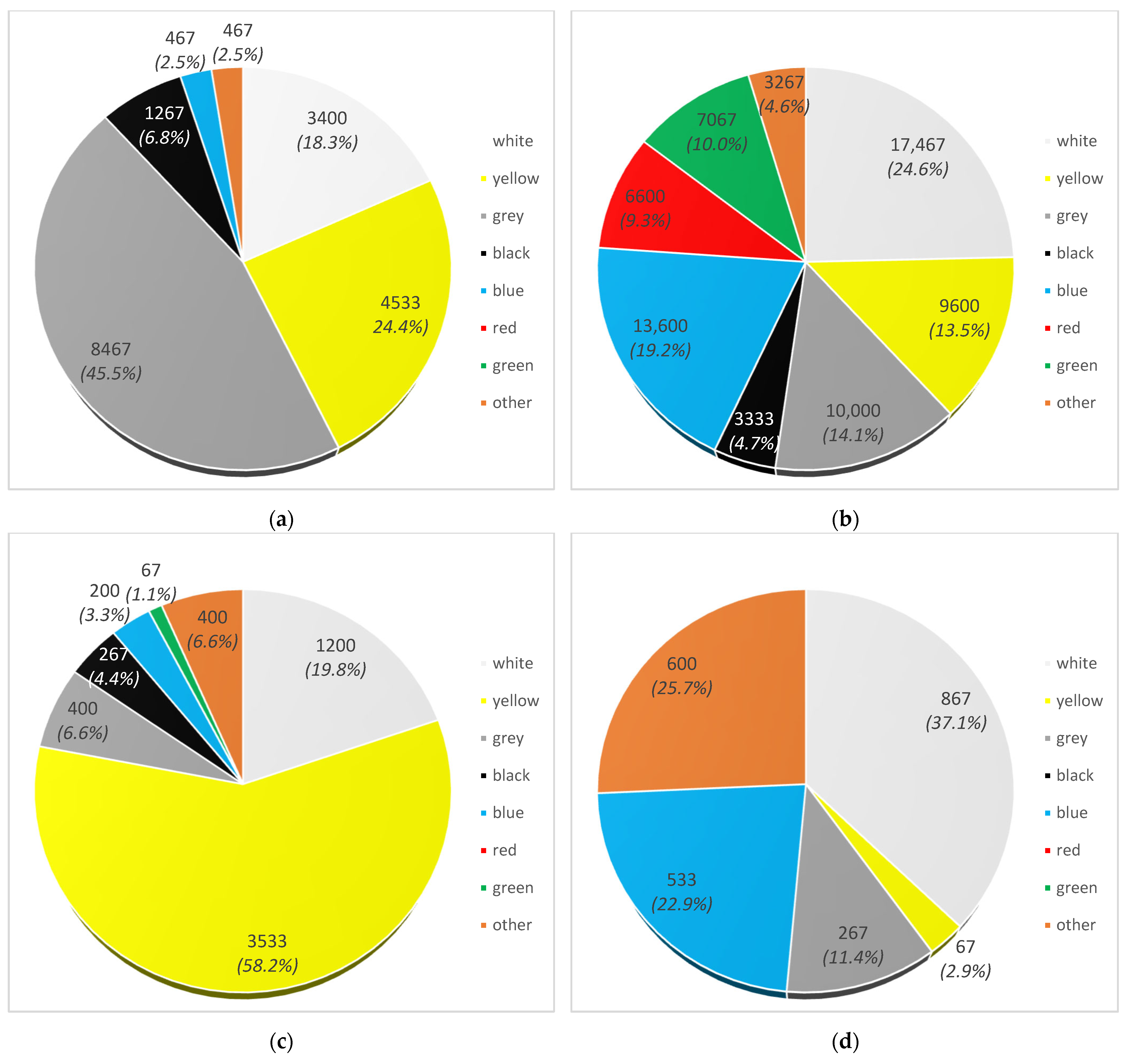
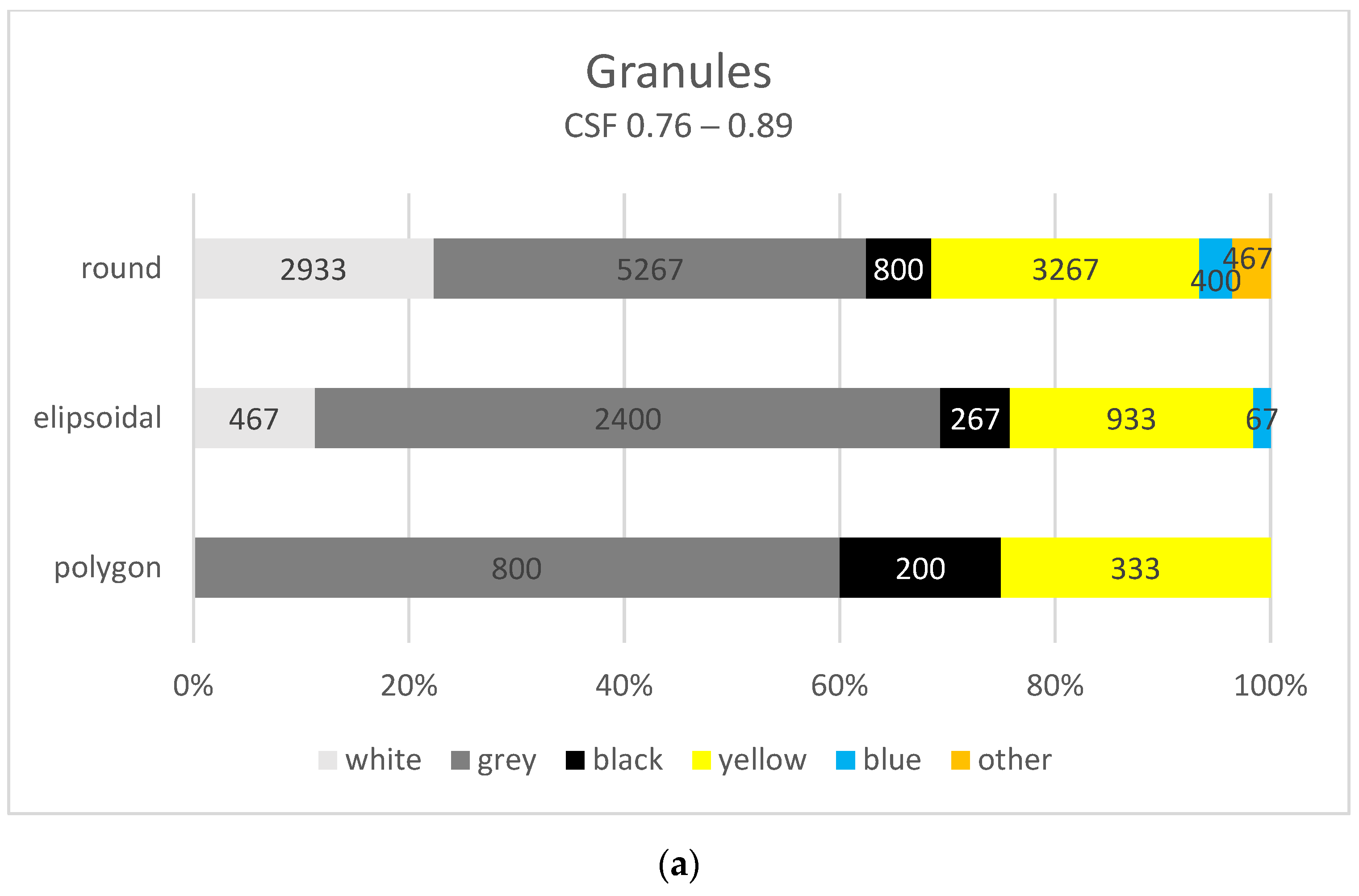
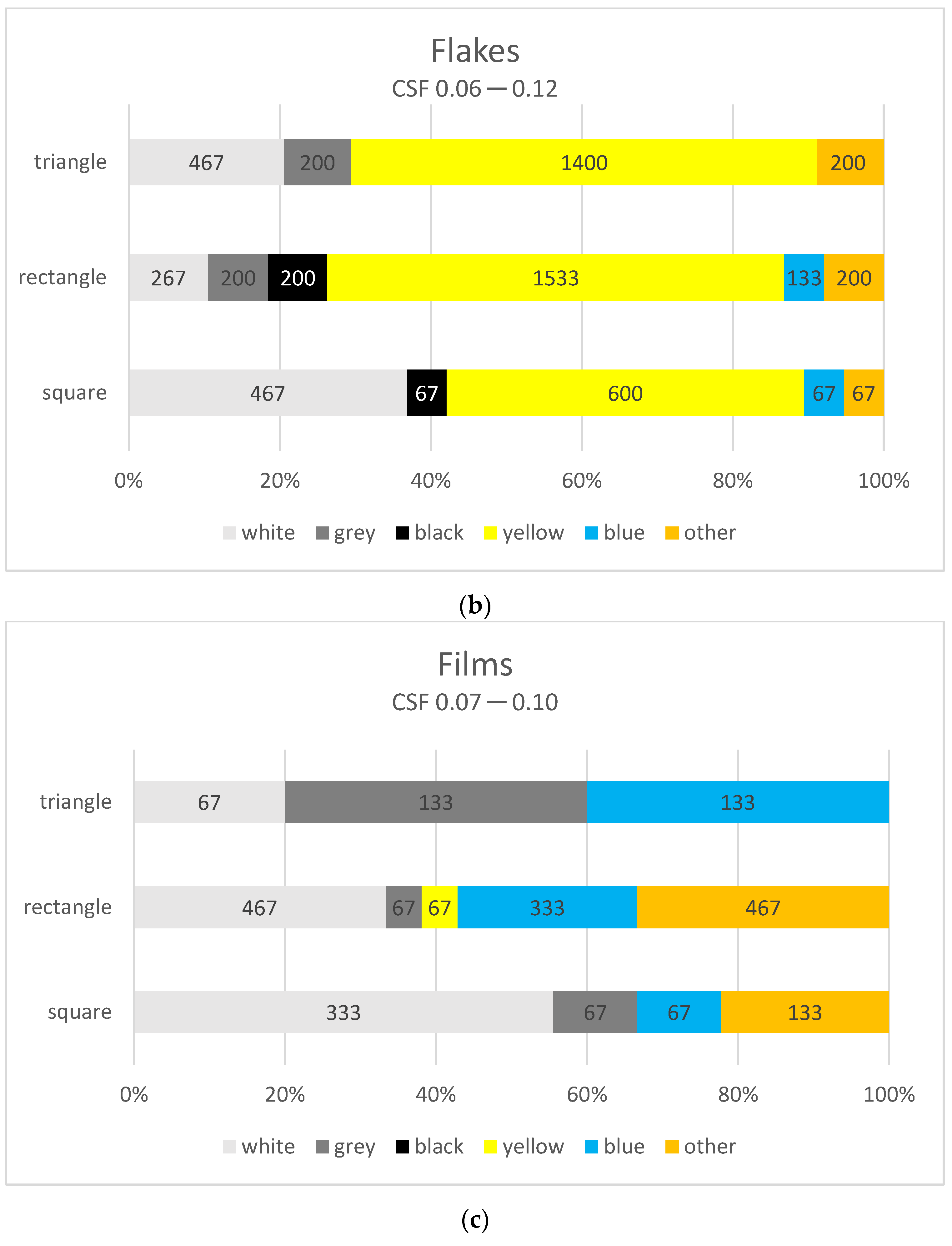
| Type of MP | 3D Regular Particles | 3D Irregular Particles | ||||||||||
|---|---|---|---|---|---|---|---|---|---|---|---|---|
| Pellets | Discs | Granules | Scraps | |||||||||
| Parameters describing size/dimension | ||||||||||||
| Descriptive statistics | A | P | DA | A | P | DA | A | P | DA | A | P | DA |
| Mean | 0.19 | 1.49 | 0.46 | 15.38 | 13.93 | 4.43 | 7.33 | 9.59 | 3.05 | 3.11 | 6.68 | 2.01 |
| Median | 0.14 | 1.40 | 0.43 | 16.35 | 14.37 | 4.57 | 8.00 | 10.06 | 3.20 | 2.79 | 6.06 | 1.88 |
| Min | 0.03 | 0.62 | 0.20 | 8.76 | 10.49 | 3.34 | 0.22 | 1.66 | 0.53 | 0.02 | 0.52 | 0.16 |
| Max | 0.97 | 3.52 | 1.11 | 19.55 | 15.66 | 4.99 | 19.71 | 15.78 | 5.01 | 19.75 | 16.02 | 5.02 |
| SE | 0.04 | 0.59 | 0.18 | 2.31 | 1.52 | 0.47 | 1.51 | 5.11 | 1.33 | 1.08 | 2.37 | 1.08 |
| Parameters describing shape | ||||||||||||
| Descriptive statistics | CSF | C | D | CSF | C | D | CSF | C | D | CSF | C | D |
| Mean | 0.98 | 0.94 | 2.93 | 0.84 | 0.99 | 2.21 | 0.83 | 0.83 | 2.67 | 0.21 | 0.71 | 2.25 |
| Median | 0.98 | 0.96 | 2.95 | 0.89 | 0.99 | 2.21 | 0.85 | 0.87 | 2.70 | 0.22 | 0.73 | 2.21 |
| Min | 0.88 | 0.68 | 2.69 | 0.69 | 0.92 | 2.14 | 0.52 | 0.21 | 2.04 | 0.02 | 0.19 | 1.60 |
| Max | 1.01 | 1.01 | 3.01 | 0.94 | 1.04 | 2.31 | 0.94 | 1.14 | 2.90 | 0.26 | 1.04 | 4.12 |
| SE | 0.02 | 0.08 | 0.07 | 0.08 | 0.03 | 0.04 | 0.06 | 0.16 | 0.13 | 0.02 | 0.15 | 0.29 |
| Type of MP | 2D Irregular Particles | 1D Particles | |||||||
|---|---|---|---|---|---|---|---|---|---|
| Flakes | Films | Fibres | |||||||
| Parameters describing size/dimensions | |||||||||
| Descriptive statistics | A | P | DA | A | P | DA | A | P | L |
| Mean | 5.46 | 8.25 | 2.40 | 8.36 | 12.38 | 3.21 | 2.94 | 12.30 | 6.15 |
| Median | 3.36 | 7.38 | 2.07 | 8.46 | 12.93 | 3.28 | 3.05 | 8.99 | 4.49 |
| Min | 0.08 | 1.05 | 0.32 | 1.75 | 4.87 | 1.50 | 0.54 | 2.71 | 1.36 |
| Max | 19.61 | 15.76 | 4.99 | 19.72 | 16.01 | 5.01 | 4.55 | 29.01 | 14.50 |
| SE | 3.76 | 4.41 | 1.09 | 4.79 | 4.23 | 0.93 | 1.38 | 9.09 | 4.55 |
| Parameters describing the shape | |||||||||
| Descriptive statistics | CSF | C | D | CSF | C | D | CSF | C | D |
| Mean | 0.11 | 0.69 | 2.11 | 0.10 | 0.59 | 2.01 | 0.02 | 0.48 | 1.01 |
| Median | 0.11 | 0.70 | 2.10 | 0.09 | 0.63 | 2.05 | 0.02 | 0.55 | 1.00 |
| Min | 0.06 | 0.19 | 1.57 | 0.06 | 0.25 | 1.65 | 0.01 | 0.07 | 1.00 |
| Max | 0.12 | 0.95 | 2.72 | 0.12 | 0.87 | 2.22 | 0.05 | 0.93 | 1.02 |
| SE | 0.01 | 0.14 | 0.15 | 0.01 | 0.14 | 0.14 | 0.01 | 0.34 | 0.01 |
| Type of MP | 3D Unregular | 2D Unregular | |||||||||||
|---|---|---|---|---|---|---|---|---|---|---|---|---|---|
| Granules | Scraps | Flakes | Films | ||||||||||
| Principal Component | PC 1 | PC 2 | PC 3 | PC 1 | PC 2 | PC 3 | PC 4 | PC 1 | PC 2 | PC 3 | PC 1 | PC 2 | PC 3 |
| Eigenvalue | 3.90 | 2.23 | 1.07 | 4.10 | 1.40 | 0.99 | 0.98 | 3.57 | 2.34 | 1.05 | 3.83 | 2.27 | 1.00 |
| % variance | 48.79 | 27.85 | 13.36 | 51.25 | 17.45 | 12.44 | 12.24 | 44.67 | 29.29 | 13.17 | 47.85 | 28.35 | 12.50 |
| % cumulative variance | 48.79 | 76.64 | 90.00 | 51.25 | 68.74 | 81.18 | 93.42 | 44.67 | 73.96 | 87.13 | 47.85 | 76.20 | 88.70 |
| Type of MP | 3D Unregular | 2D Unregular | |||||||||||
|---|---|---|---|---|---|---|---|---|---|---|---|---|---|
| Granules | Scraps | Flakes | Films | ||||||||||
| Variables | PC 1 | PC 2 | PC 3 | PC 1 | PC 2 | PC 3 | PC 4 | PC 1 | PC 2 | PC 3 | PC 1 | PC 2 | PC 3 |
| Colour | 0.08 | −0.05 | 0.90 | 0.15 | −0.04 | 0.46 | −0.88 | 0.06 | 0.08 | −0.74 | 0.13 | −0.29 | −0.75 |
| 2D shape descriptors | |||||||||||||
| Shape 2D | 0.07 | 0.50 | 0.50 | −0.14 | 0.18 | 0.87 | 0.43 | 0.06 | −0.12 | −0.71 | 0.17 | 0.31 | −0.65 |
| A | −0.82 | 0.53 | −0.04 | −0.81 | −0.55 | 0.03 | −0.02 | −0.68 | −0.71 | −0.02 | 0.58 | 0.80 | 0.02 |
| P | −0.70 | 0.70 | −0.04 | −0.94 | −0.27 | −0.02 | −0.03 | −0.87 | −0.49 | −0.01 | 0.92 | 0.36 | 0.07 |
| DA | −0.83 | 0.55 | −0.04 | −0.90 | −0.42 | 0.03 | 0.00 | −0.73 | −0.67 | 0.00 | 0.61 | 0.77 | 0.02 |
| 3D shape descriptors | |||||||||||||
| CSF | −0.83 | −0.54 | 0.08 | 0.83 | −0.31 | −0.06 | 0.00 | 0.73 | −0.67 | 0.04 | −0.85 | 0.51 | −0.05 |
| C | −0.83 | −0.55 | 0.07 | 0.55 | −0.66 | 0.18 | 0.15 | 0.75 | −0.65 | 0.04 | −0.85 | 0.51 | −0.04 |
| D | −0.83 | −0.54 | 0.08 | 0.84 | −0.52 | 0.03 | 0.07 | 0.85 | −0.50 | 0.01 | −0.88 | 0.46 | −0.05 |
Disclaimer/Publisher’s Note: The statements, opinions and data contained in all publications are solely those of the individual author(s) and contributor(s) and not of MDPI and/or the editor(s). MDPI and/or the editor(s) disclaim responsibility for any injury to people or property resulting from any ideas, methods, instructions or products referred to in the content. |
© 2024 by the authors. Licensee MDPI, Basel, Switzerland. This article is an open access article distributed under the terms and conditions of the Creative Commons Attribution (CC BY) license (https://creativecommons.org/licenses/by/4.0/).
Share and Cite
Dacewicz, E.; Łobos-Moysa, E.; Chmielowski, K. Identification Tools of Microplastics from Surface Water Integrating Digital Image Processing and Statistical Techniques. Materials 2024, 17, 3701. https://doi.org/10.3390/ma17153701
Dacewicz E, Łobos-Moysa E, Chmielowski K. Identification Tools of Microplastics from Surface Water Integrating Digital Image Processing and Statistical Techniques. Materials. 2024; 17(15):3701. https://doi.org/10.3390/ma17153701
Chicago/Turabian StyleDacewicz, Ewa, Ewa Łobos-Moysa, and Krzysztof Chmielowski. 2024. "Identification Tools of Microplastics from Surface Water Integrating Digital Image Processing and Statistical Techniques" Materials 17, no. 15: 3701. https://doi.org/10.3390/ma17153701





